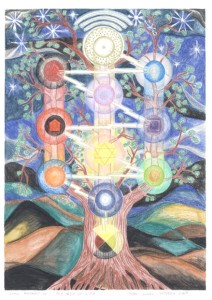Hi Everyone,
One of the main foundations of meditation practice is the development of awareness, but what exactly is it that we should be developing awareness of? The following is a list of four basic aspects of your awareness and awareness practice that you need to be working with continually in order to ensure the balanced growth of your being on all levels.
It is based around the four areas identified by the authors if “Integral Life Practice” , which is a book I highly recommend (I use it for both my own personal practice and for coaching with clients). Of course there are many other areas of awareness training, but these four really seem to be a stable “must have” set of building blocks for other forms of awareness training as well as integral inner growth and integral service to the world:
1. Awareness and processing of our shadow self – Our shadow self is any aspect of our self or being that is currently denied, unacknowledged or unexpressed within us. These can be aspects of ourself that we are afraid of, such as powerful negative emotions, but they can also be aspects of ourself that are actually powerful positive potentials which have been denied by us due for example, to lack of confidence or self esteem. These positive hidden elements of our shadow are sometimes called our “golden shadow” as they reflect the potential positive, balanced, dynamic person we could be. Shadow awareness practice is the art of becoming aware of that which is hidden within us and bringing it out into the open either to be healed (in the case of negative shadow elements) or brought to their full potential, as in the case of golden shadow elements
2. Awareness of Mind – This is a big area, but the particular aspect of awareness that I want to highlight with the mind is an ongoing commitment to develop awareness of higher, deeper, more complex perspectives. Right now our perspective is limited, biased, and narrow. To commit each day to seeing new perspectives, learning new ways of working in the world and in our relationships, understanding other people’s points of view, expanding the breadth of our motivation are all activities that expand our mental and intellectual awareness, making it more profound, inclusive and integrated.
3. Awareness of Body – Here awareness of body means awareness of your THREE bodies, gross, subtle and causal:
- Gross physical body training involves physical trainings such as weights, stretching, sports and all forms of gross body fitness training.
- Subtle body awareness training involves subtle body practices such as qi-gong, tai-chi, prajnayama (breathwork), certain yoga trainings, and so forth.
- Causal, or stillness body training involves getting in touch with our formless, expansive, universal spiritual body. We contact and develop awareness of this primarily through meditation practices that still and focus our consciousness.
4. Awareness of Spirit – We can develop an awareness of spirit in many ways, but here are three, based around a way of relating to spirit in first, second and third person:
- Spirit as I (first person) – Developing awareness of the spirit that lives within you (Spirit as “I”) through stillness meditation
- Spirit as “ Thou” or “you” (second person) – Developing awareness of spirit as something or someone that we pray to for help, guidance, inner healing and communion
- Spirit as “It” – Developing a sense of wonder and mysticism in our contemplation of the structure and beauty of the Universe. For example when we stand in awae of a beautiful sunset, or a starry sky.
Four Minute Meditation on these four aspects of integral awareness
So, I realize that the above may all seem bit abstract, so here is a very simple, practical way of starting to experience them all within a short four minute meditation, I think even if you read through it now, slowly and mindfully you will start to get a feel for it:
Minute 1 – Working with your shadow:
Sit quietly and follow your breathing. As you do so, be aware of the feelings and images arising inside your mind. Without either pushing them away or getting totally absorbed by them, be aware of any fears and anxieties that may be running beneath the surface of your awareness. Sit with them.
Minute 2 – Working with the perspectives in your mind:
Continuing to use your breathing as an anchor for your awareness, bring to mind a situation that you are experiencing in your life right now. Within the space of one minute, try and consider it from as many perspectives as you can. See your own personal perspective. Try to see and understand the perspective of another who is participating in the action. What would someone who has no involvement in the situation think? What is the big picture? How would an enlightened being view the situation? What is the significance of it likely to be looking back in a year, 2 years, 10 years?
Minute 3 – Working with your body:
For the third minute, try and focus on relaxing physical tension in your body. Then try and sense or feel the subtle currents of energy flowing through your subtle body. Somewhere within the centre of your torso there is a point of stillness, can you find it?
Minute 4 – Working with Spirit:
For the final minute simply try and let your mind be a still and tranquil as you can, use the breathing if you feel you need a point of physical focus, but otherwise go as deep within the core of your being as you can.
End with a prayer that the energies of your meditation may be a cause for the happiness and wellbeing of all creatures.
Thanks for reading!
Yours in the spirit of integrated awareness,
Toby
PS: Final reminder regarding new meditation classes starting this Tuesday 15th March on “Finding Calmness, Order and Purpose in the Complexity of Modern Life; Meditations for Developing a Fully Integral Awareness” I’m quite excited about it. Do feel free to click on the link for details, if you are not in Singapore but are interested in it, the course will be available as MP3 recordings, so just let me know if you would like copies!
Article ©Toby Ouvry 2011. You are welcome to use this article, but you must seek Toby’s permission first. Contact info@tobyouvry.com
 Today my daughter came home from from school quite unhappy about something that, from an adult perspective was clearly a “not important”. I could feel my irritation building, my answers to her were becoming shorter and more pointed. Something like “I’ve got enough hassle, why are you bothering me with this nonsense” was what I was saying to myself in my mind.
Today my daughter came home from from school quite unhappy about something that, from an adult perspective was clearly a “not important”. I could feel my irritation building, my answers to her were becoming shorter and more pointed. Something like “I’ve got enough hassle, why are you bothering me with this nonsense” was what I was saying to myself in my mind.







